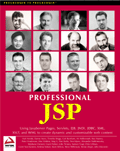New to Java? We'll help you get started with our revised beginner's tutorial, or our free online textbook.
|
|
 Get the latest Java books |
|
|
h t t p : / /w w w . j a v a c o f f e e b r e a k . c
o m /
|
||
|
Menu Articles Using Java Applets Looking for Java resources? Check out the Java Coffee Break directory! |
Professional JSP Excerpt
This chapter examines a variety of ways to architect a system with Java Server Pages, Servlets, and JavaBeans. You will see a series of different architectures, each a development of the one before. When Sun introduced JSPs, some were quick to claim that Servlets had been replaced as the preferred request handling mechanism in web-enabled enterprise architectures. Although JSPs are a key component of the J2EE, we must investigate further to understand its relationship with Servlets. Understanding that JSP is built upon the Servlet API, and utilizes Servlet semantics, raises some interesting questions. Should we no longer develop standalone Servlets in our web-enabled systems? Is there some way to combine Servlets and JSPs? If so, where do we place our Java code? Are there any other components involved in the request processing, such as JavaBeans? If so, where do they fit into the architecture and what role do they fulfill?
©2000 Wrox Press Ltd. Used with permission. |
||||
|
|||||



 The following extract is from Chapter 12, of
Professional
JSP, from Wrox Press.
The following extract is from Chapter 12, of
Professional
JSP, from Wrox Press.